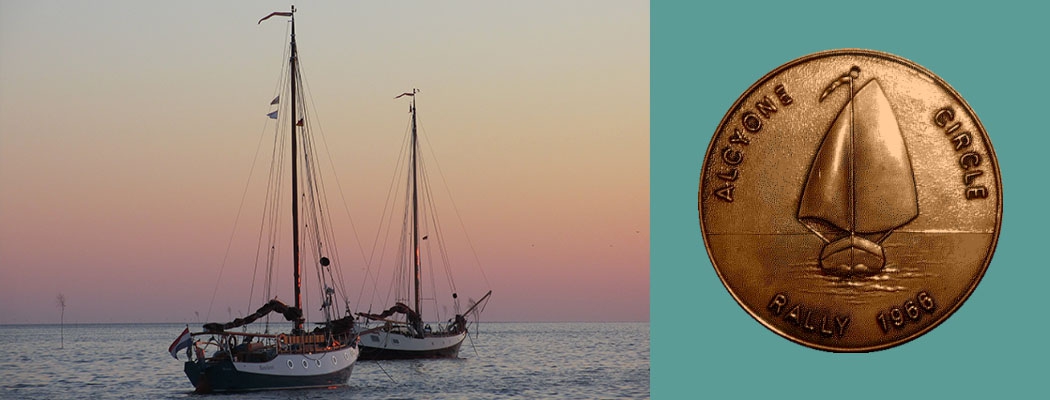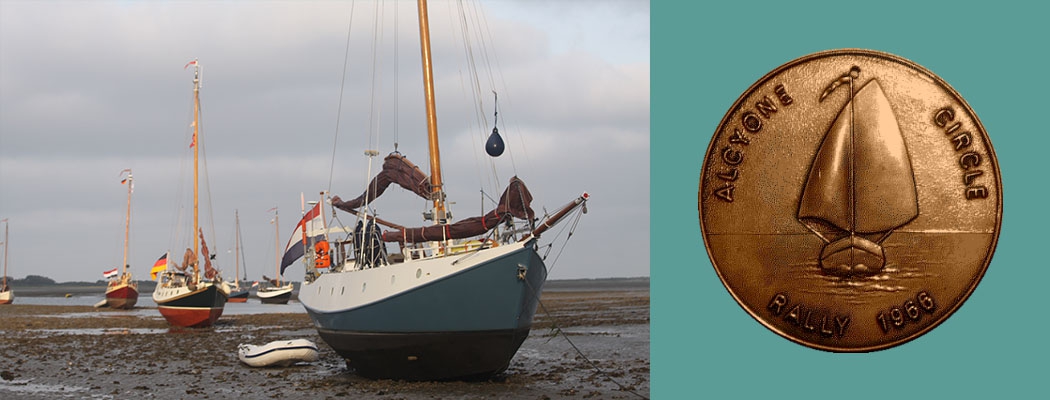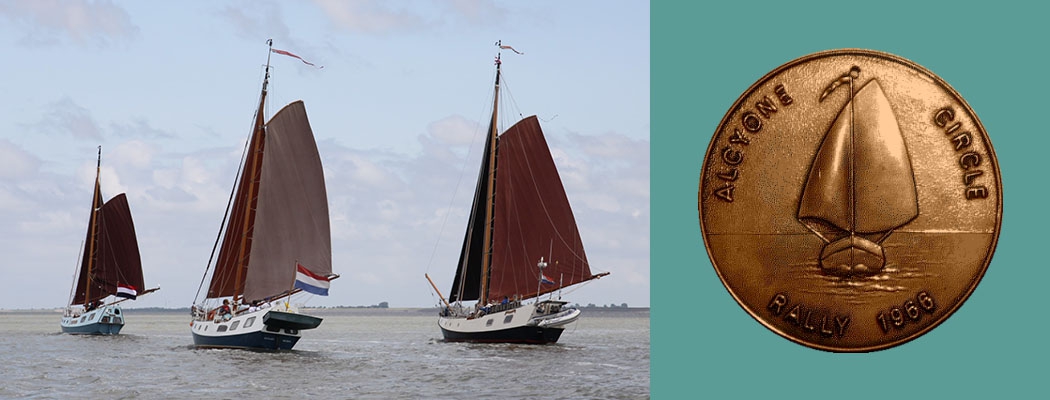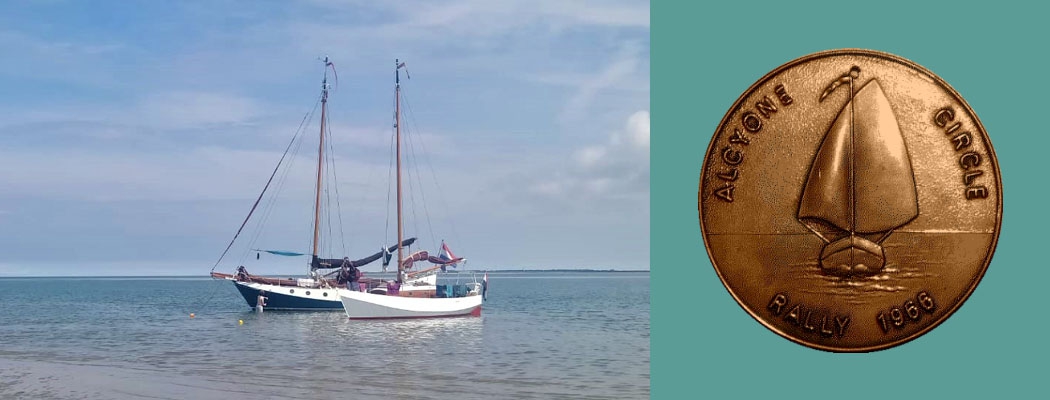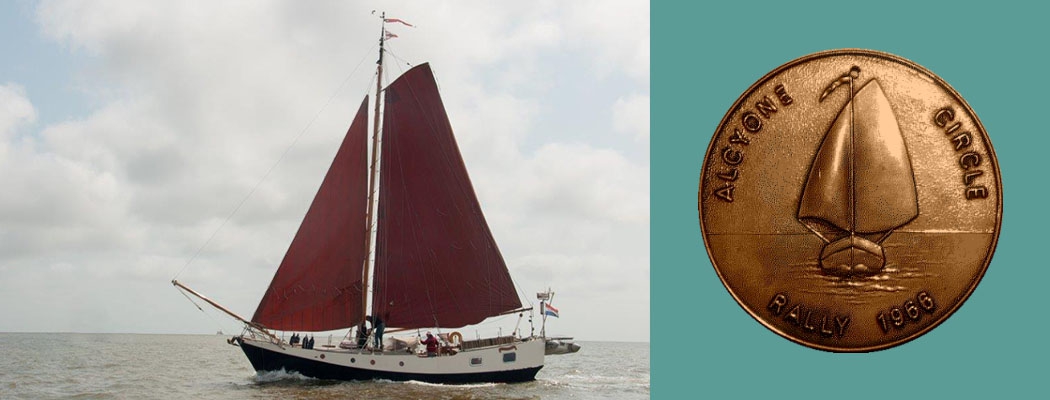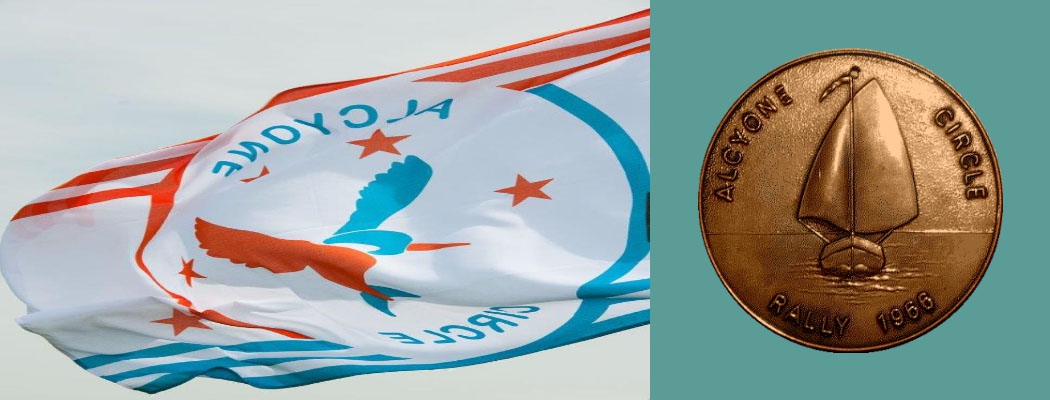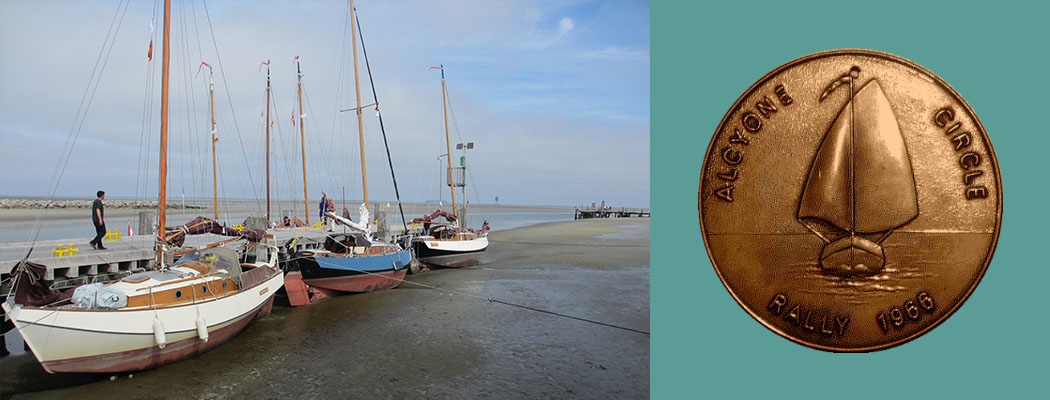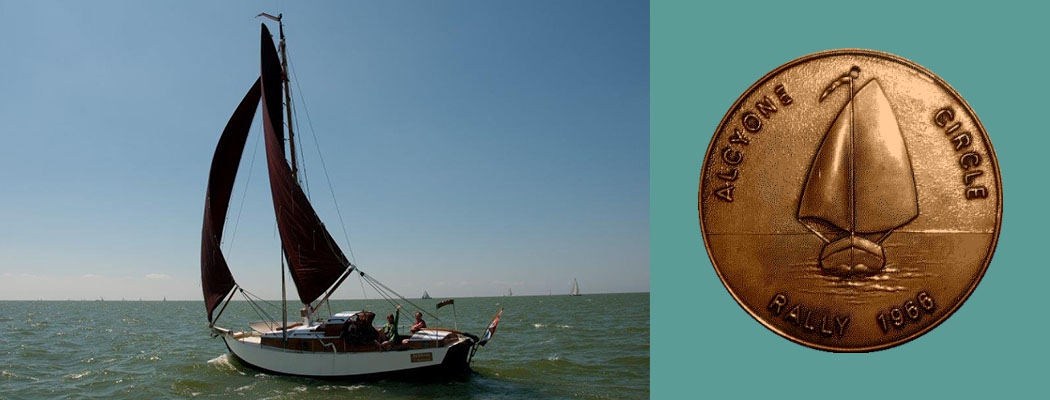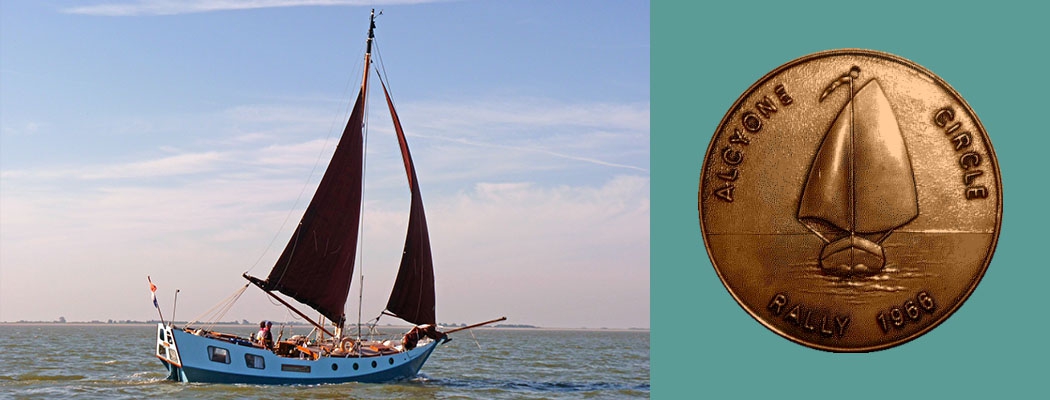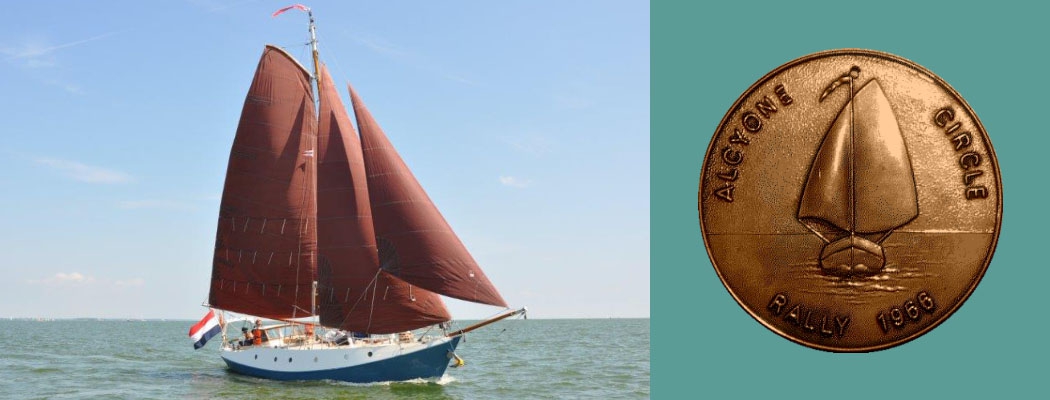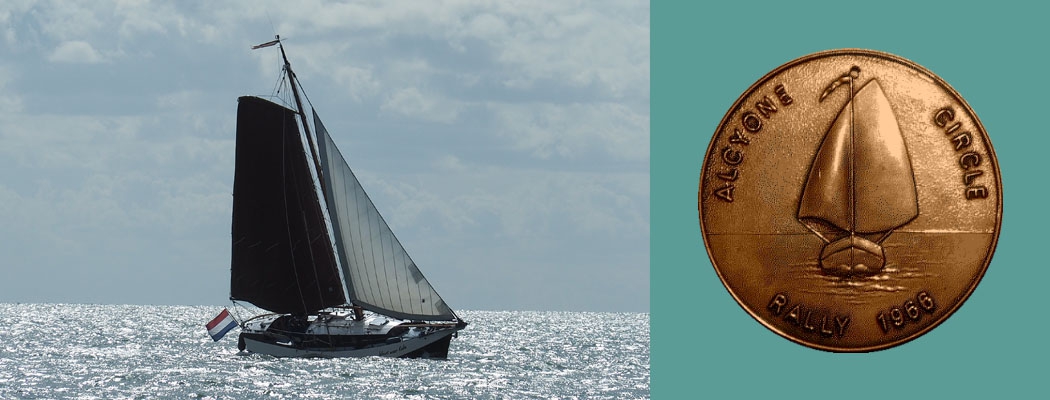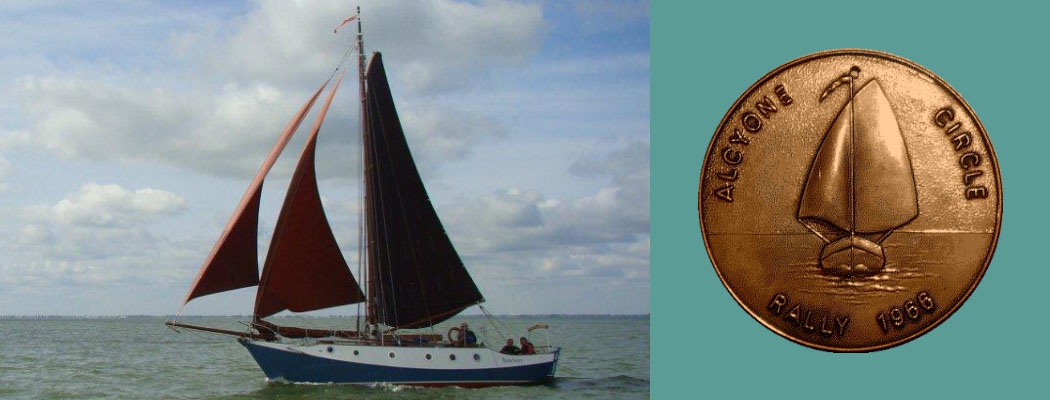 News from Mr. M.F. Gunning.
News from Mr. M.F. Gunning.
We are very grateful to Mr. Gunning for his tratise about “steering and Selfsteering”, which follows underneath.
Steering and Selfsteering
The original “Alcyone”s are hard on the helm; there is no denying the fact. The fault can be mitigated by not over-canvassing the boat, and reefing in time, but still the experiments were devoted to the finding of a remedy, but it soon transpired, that the usual theory of relative positions of centre of lateral resistance, and centre of effort (i.e. of sail area) just did not apply. Even under jib only, with the centre of effort yards in front of the centre of lateral resistance the boat will luff, as soon as it builds up any sppeed at all, and so builds up a bow wave.
The last words were found to contain the solution of the problem. These boats build up quite a large bow wave at any speed, and, when heeled, the lee bow wave was considerably larger than the windward one. This naturally pushed the bow up the windward. There were two ways of remedying this, one being to reduce the displacement at the bow, and the other to reduce the resistance to any flow from the lee-side to the windward side, underneath the keel or skeg, right forward.
This was first tried out in “Sayonara”, but we lost touch with her, and never got a proper report as to how she behaved. This winter, however, I was positively assured by the new owner, the she is easy on the helm, uner any conditions. If I had known this sooner a great deal of worry might have been saved.
However, the “Cormorants” were designed on the same principle i.e. with the keel plate drawn up nearly to the waterline forward, so as to reduce the displacement there, and, with it, the bow to wave. They turned out to be alright. The same procedure was asopted for “Banckert”, again with complete success, so that now this particular problem seems to be solved.
I tried to work out a modification for existing craft, but Valentijns assure me, that it would be too difficult and expensive to work out in practice, so I am afriad, that nothing much can be done.
However, Capt. Sanders has hit upon an idea which may well be of great help. He is cutting off the 8” plate that was fitted to the rudder in order to help steering, and is fitting two auxiliary rudders about 10” to port and starboard of the man rudder, and about 5” in front of it, high about 30” aerfoil shaped. They are supported on small lugs fitted to the rudder proper. As their centre of gravity is well in front of the rudder stock they will tend to stabalize the rudder, and greatly reduce the force required at the hem. A very rough calculation showed that perhaps the helm-force might be reduced to know, how this experiment will pan out in practice. A small draw-back will, of course, be the added resistance of the side rudders, but in the shipcuilding, as elsewhere, oe never gets anything for nothing.
Talking about steering, the last letter told how I helped “Spurwing” with her self-sterring gear. This sconsists of a windvane, which can be set to the wind, and which acts on a small auxiliary rudder, or tab, fitted to the main rudder. Most small craft have this tab fitted to the after nd of the rudder, but if great force is required to lay the rudder to any angle, it is obvious, that it is better to place the tab further aft, so as to increase its leverage.
This was done on “Spurwing”, and seemed to work alright. Whe fitted in Gibraltar the main fault of the gear proved to be a certain weakness in resisting a judder caused by the heavy counterwight. Naturally the vane must be quite independant of the heel of the vessel, so a counterweight is always fitted. The vane was too heavy, hence the counter-weight was too heavy. Now the tab, like any rudder, started to vibrate at certain speeds, and this vibration was picked up and magnified by the masses of vane and counterwight till a judder was built-up that threatened to break-up the whole gear, and which necessitated some reinforcement. Once seen the fault was obvios, and easily avoided in a new design. Poor Sir Percy had to pay for the teething troubles.
However, as appears from his logs, he is all well satisfied. He writes: “whatever I say Max (and there are quite a few critical remarks), do realise that the vane has transformed “Spurwing” from a slave ship, where one of us had to be at the helm every hour of day and night, to a position where the man on watch is skipper of the ship and with adjustments to the vane need not in anything of a breeze steer the ship at all.”
Now, thinking hings over, was this gear with an auxiliary tab the best choice? Tabarly in his book on the single-handed transatlantic race describes a lot of these gears, starting with the “Miranda” of Chichester (winner of the first race.) This is a very large sail, acting directly on the main rudder, via the helm. He has made it work, but with great trouble, and I think the gear becomes altogether too big, if it has to deal with a hard-mouthed boat like the old “Alcyone”. Then there is the auxiliary tab, executed in a number of ways, and finally an auxiliary rudder, operated directly by the vane, which steers the ship. I never thought much of this idea, till I found a full description in the last “Yachting Moonthly”. I was under the impression that the ship is steered by the mainrudder till an average angle of the helm is found. Then the helm is fixed in that pocition, and the auxiliary rudder engaged, which now merely has to make secondary corrections. This idea appears to be a good one (in fact the gear of Tabarly worked on this principle) but the trouble on the “Alcyone’s is, that it is difficult to fit the auxiliary rudder completely clear of the main one.
So I feel, that further efforts should be directed to perfecting and greatly simplifying the gear of “Spurwing”.
Warning
It will be seen that the rudderstock is supported in three places; a bearing right at the top, a solid pintle at the bottom and a sort of ring in the middle.
It has been found on “Spurwing” this latter bearing has worn to an appreciable extent into the rudderstock. The latter is made of reletively thin tube, consequently a considerable part of its strength was gone.
On “Spurwing” this has been mended by cutting the rube in two at the worn part and inserting a well fitting piece of round bar and welding all round.
To detect any wear the rudder should be lifted slightly relatively to the skeg.
Revised List of Ships and Owners
A revised list detailing the latest changes in Ownership is an annex to this Newsletter. “Fanny’s Puffin”, “Milly Dolly”, “Margaretha”, “Phoca”, Vrouwezand” and “Coot” will be commissioined this season.
News About Ships and Owners
“Carapace”
It is always a pleasure to hear about the experiences of Mr. Bullerjahn! In the first place because he is a keen yachtsman, in the second place because he is enthusiastic about his Alcyone I class ship “Carapace” and in the third place because he tells us about yachting on the East Coast of the United States. I quote from his letter:
“At Newport, by the way, we were challenged to race against a fleet of boats chosen for their individuality. The 12 meters were giving us such a poor show that every one was bored and as a result we had the whole spectator fleet out to see us! The vessels were “Black Pearl” a 51 foot Brigentine, “Free Lance” a 90 foot tops’1 Shooner, “Flevo a 52’9” Botter (G. de Vries Lentsch, Jr 1938), “Integrity” a 60 foot tops’l Schooner (built to Maine Coast fisherman lines) and three smaller schooners built to Coaster lines.. We were the smallest vessel by far. The next larger being about 38’ on the waterline. The course was a beat up Naragansett Bay, around a large island and back down on a broad reach. We were very pleased to find that we went through the water faster than any of the others… footing and pointing better, eventhough we were under cruising canvas alone and the fleet was sporting some marvellous kites. We were well on the way of winning when we were fouled by “Free Lance” (she refused to luff up and was there by disqualified) but with her thousands of feet of canvas to weath er of us, we might as well have been in a bottle! As it was we came in 3rd… The protest meeting was quite hilarious as “Free Lance” was protested successfully by 4 others beside us.
One other incident to cheer Mr. Gunning’s heart. We sailed from Marblehead to Boston to watch the Tall Ships (Tall Ship Race 1964) come in. It was blowing 30-35’ from the NE so we had a merry time going down to Boston. The sea was very confused because of tide, shoaling, and the fact that a gale had been blowing from the NW for some days before. It was delightful even though we had an unusually large party aboard (6 adult and 3 children) a thing we have avoided so far in our sailing. We had several EYC boats with us and it made an exciting morning morning despite the rain and over cast. After sailing about in very crowded waters at what seemed incredible speed.. the harbour being very smooth and the wind somewhat stronger, we set sail for Marblehead. This time against a really strong headwind and a most spectactular, steep, confused sea. In company was a 65 foot Alden schooner with four paid hands aboard. She seemed at first to be standing out for another destination but we soon saw that she was being forced down by the seas.. she was wet from bow to stern. we, however, were able to make the marker of Marblehead on one board and we were completely dry in the cockpit! Later we saw the chooner’s owner and he said that they has all they could take and were concerned about us! We didn’t even have any loose gear below!”
“Vrouwezand”.
The Cormorant type ship “Vrouwezand” was at 13-3-65 delivered to its owner, Mr. Huurman, who finished her off himself.
“Milly Dolly”.
Mr. Rouse hopes to sail with “Milly Dolly” n the coming season. He bought this ship as a casco and finishes her off himself.
“Spurwing”.
As already mentioned in Newsletter nr. 4 Sir Percy Wyn Harris is making a voyage from Gibraltar to the West Indies. After staying there for some time he intends to sail “Spurwig” back to England and hopes to arrive in August 1965. “Spurwing” is now crossing the Atlantic and we do hope, that the Northeast Tradewinds are kind to her and to her skipper and crew.
As will be remembered a steering vane is installed in “Spurwing”. The propeller is of the normal type, so cannot be set in a vane position and therefore will have some drag. Her owner estimates that her maximum speed will not exceed 6 1/2 knots.
Sir Percy wrote in a letter: ….”From the log you see what a wonderful seagoing vessel I think she is. We have wandered up the Gambia and … I could say that she had been up the river faster than any other yacht; when we shot crocodiles, had to lower mast in overgrown creeks… Looking forward to our journey across. No other ship could have done up the river what old ‘Spurwing’ has done.”
Sir Percy most kinldy consented that his personal log is published in our Newsletter and we thank him very much for this gesture.
Underneath follows the log from Gibraltar to the Gambia.
“Spurwing”
Personal log of Sir Percy Wyn Harris.
“From Gibraltar to Gambia.
It was oast midnight of December 2nd before our last visitors final ly said goodbye and vanished down te dark quay with the lights of the rook twinkling over us and a gusty N.W. wind blowing. I had hardly got int my bunk when I was summoned on deck by two cus tom officers looking for a boat which was not us. They came on board and cleared us, but the upshot was that I did not get into my bunk again until after two, and overslept the 3:30 alarm. It was not until near dawn about 7:15 that Dave had stowed the fendoffs and warps and we moved out of the harbour in the half light and in a good breeze from Northweat. We moved on the engine and met three frigates coming in which made us hurredly put on our navigation lights. Outside the harbour we set mainsail and staysail and set Virginia, our new wind vane, and close reached across Gibraltar Bay in a force 4 wind. After playing with the Vane and steadying the tiller with shock cords, virginia began to steer excellently and kept us on course. At 11 AM we were creaming westward, but we had got a little too far from the slack water near the spanish coast and found ourselves in the 4 knot surrent which pours into the Mediterranian on the East going tide, so we made little throught the water at 5 knots. Once over on the African side of Straits when the tide is running hard and we bounced though some nasty lumpy seas. But Virginia sailed us through them very well and Dave and I realized we had got a self steering device which was going to save us may weary hours at the tiller. We were off Tanger just before nightfall and with one tack we cleared Cape Spartel. I was very glad to see the Cape and get the long swell of the Atlantic instead of the beastly motion in the Straits. I had had to do quite a bit of chart work in the cabin. Rocky our little cat was fairly miserable that evening. Cape Spartel is on the African Coast and marks the Western end of the Straits of Gibraltar and by 9 PM on a dark and moonless night we took our departure from three miles west of the light.
By morning of the third the wind was lighter and we had to use the engine as well as sail. By evening of the third the wind freshened and we sailed all night of the third/fourth on our course about 40 miles from the African coast with Virginia steering.
As we did not have to steer we could spend quite a lot of our watch time down below with the occasional glance at the compass and look round to see that there were no other ships about.
As we are on the direct run from the Straits of Gibraltar we met quite a surprising amount of traffic and at one time I could count five different lights. Some of these were probably fishing craft out of Casablanca. There was not a cloud in the sky. The wind from the Northeast was fairly cold and was sendind us along at about four knots. The plough was immediately over our stern with the Polestar on our starboard quarter.
Overhead Orion with its great circle of Sirius, Proceron, Castor and Pollux was weeling out of the East and crossing our bow. During all this passage I was taking sexant angles of the sun and plotting position lines. On the fourth we set the Genoa and had to readjust Virginia. Our days’ runs were not very good as for much of the time the winds were fairly light, and we did not use the engine as long as the ship would sail more than three knots. For nearly two days we did not see any other vessels but on one morning when we were nearly 100 miles off the African coast a small landbird about the size of a finch but with a longish beak slighted on the gallows. It may have been a migrant, but I think not and it must have been blown out to sea. I have seen birds on board in the North sea on a windy night, but never so far from land before.
About sunset on the evening of December 7th we picked up just forward of our port beam at a distance of about thirty miles some hills which I was able to identify from the line drawing in the admiralty Pilot as Alegranza the most northerly of the Canary Islands. This put our position as correct with Gran Canaria 150 miles ahead of us on compass bearing 226º. During the morning of the ninth I got a sextant altitude of the sun I found that we were about twenty miles too far west. I therefore put on the direction finder, which I hoped not to have to use and found that Las Palmas was indeed on our original course. I therefore rechecked the figures for the posi- tion line to find a silly mistake in taking out the figures which i had overlooked. By 5 PM in a freshening wind of force 4 to 5 and under main and genoa we picked up the hills behind Las Palmas harbour on our starboard bow and in a splendid breeze we rapidly raised the lights of Las Palmas as the night set in. It was difficult to distinguish the green flshing light marking the harbour entrance, against the flashing neon signs of the city, se we got sail of her when we were about a mile outside the harbour and came in on the engine. We got in about 8:45 PM and wandered around in the dark looking for a berth in this very large harbour. We finally found a group of yachts in a huddle in a corner and so anchored with two anchors as the holding around was very poor and on one started dragging.
Dec. 9th.
It has been a most enjoyable passage, made easy by the stalwart work of Virginia. Dave has been a good companioin and crew. Twice on the passage he had to climb to the top of the mast to free jammed halliards; no mean feat in a wildly rolling mast with no rat lines on the shrouds
The morning after our arrival we lay in the late and renewed several acquaintances on the other yachts, who Dave and I have met in Gibraltar.
There are nearly a dozen yachts waiting here before making the passage to the West Indied. …
There are several jobs to be done such as getting an electronics engineer on to the echo-sounder which is not working properly and we will want it in the Gambia. Also our water tanks, thanks to the administrations of the bum who poured paint into them will have to be washed out as we are drinking water tasting strongly of watertank paint, harmless but unpleasant.
The next issue of the log will I hope come from the Gambia at the end of the month.”
From Gran Canaria to the Gambia
We had hoped to leave Las Palmas about December 16th, but it did not happen that way, for on te 15th a deep depression centred in the Straits of Gibraltar, made its presence felt as far south as the Canaries. It was most unusual for this time of the year. No small craft were allowed to leave the harbour and the big seas outside brought a swell into the harbour. We rode rather unhappily to our two anchors in an open moor and hoped we would not drag in the very poor holding ground. We oiled, watered and provisioned on the 18th and had an enchanting farewell dinner.
On the 19th the Port Authority told us the port was still closed to small craft leaving so it was not until the morning of the twentieth with a sad farewell to Diana, we got in our anchors and at 10 AM in a fresh north westerly got away under all plain sail. Without the help of the engine we swept round the other ten yachts lying to the anchors and creamed past the shipping to the accomplishment of blasts of farewell from the foghorns of the anchored yachts.
As Virginia, the Vane, had sailed us most of the way from Gibraltar Dave felt like a bit of steering, so he took the helm and we sailed south along the east coast of Gran Canaria at a clipping rate. We streamed the log in the harbour entrance and kept on sailing well until 2 PM when under the lee of Gran Canaria mountain the wind backed ahead and became fickle and light. We had to tack out to sea. By 3 PM the wind freshened again from the N.W., but to windward the weather looked anything but kindly. Heavy clouds lay over all the peaks of the Island, while directly astern a brute of a black pall with all the stigmata of a line squall came racing up. Line squalls at this time of the year are most unusual, but this was unusual weather! By 3:15 PM Gran Canaria was almost lost under dark clouds and the sea already anything but quiet already began to rise rapidly with white clouds all around. We first scandalized the main sail. -Scandalizing is a highly effective and quick method of reducing sail. It is only possible with the old fashioned loose footed gaff mainsail of the kind carried by “Spurwing”, whose rig is in the ancient Dutch traditioin. Scandalizing consists of hauling the tack of the mainsail up the mast like a blind, so tat there is an immediate and very considerable reduction of sail area oresented to the wind, The peak is then dropped still further reducing the effectiive area of the sail.- As the wind freshened I decided to dowse the main altogether and run in the rising wind with staysail alone. Dave got the main down after a struggle but the hauling part of the topping lift was too thick for our new jambcleat and it came adrift letting the boom down with a run on to the starboard guard rail, breaking off the main stanchion at its base. We ran well on our course of 223º Magnetic to a point about 70 miles out in the Atlantic due West of Cap Blanc, which itself is the boundary between the Spanish Sahara and Mauretania.
The wind prooved to be the last squall of the bad weather, so we got down to repairing the rail as with 1000 miles ahead of us to Gambia we had to have a gaugrd rail which works. We finally made a substantial repair by hammering a tubular spanner into the deck socket and then forcing the tubular deck stanchion on to it. It was to our pleasure as strong as ever. By 9:15 PM the wind had died away leaving a beast of a lump of sea and we rolled disgustingly, so we hauled the staysail amidships and started the engine and the roll quieted considerably.
By 11 PM we had dropped the last light of Gran Canaria and I left Dave on watch at 7 PM who recorded this and also that it was a lovely night, windless with a full moon.
On Monday December 21st at 00.30 I took over the watch and shortly after got a light breeze on the starboard bow which enabled me with some adjustment of shock cord to get Virginia to call us roughly on course.
At 8:00 AM after an easy night because of Virginia we got a light breeze on the starboardm so Dave set the main and genoa and we stopped the engine and sailed. At this point I found a tremendous amount of oil in the engine bilge and traced it in the end after crawling round the engine bilge to a leaking cover of the gearbox. The leak had been caused at Malta, by the yard stripping one of the bolt holes of its threads. After some trouble managed to solve it by a longer bolt and a backing nut. Felt somewhat sickish at the end. By 11 AM the wind had fallen very light so we started the motor and putted along over a blue and gently rolling sea. It appeared we had left the bad weather behing, but where, oh where were the Trade Winds. During the morning we saw no shipping and at 1.04 which was the meridian transit of the sun over the ship I took a sextant altitude of the sun being 23º26’6 south. Our latitude was 26º37’8 North and the log shot at the sun we found ourselves rather too far to the west so changed course to South True. We set the main and the genoa and with a steadily freshening wind onour starboard quarter and the engine stopped we began to make tracks. First about 4 1/2 knots, then just before sunset 5 1/2 then as the light faded over 6 and sometimes 6 1/2. Virginia began to show her style and our watches were easy as she sailed the ship for us. She obviously alters course to shifts in the wind as it is that by which she sails, but in a good breeze she is wonderful helmswoman.
During the evenings we saw the lights of three ships, so we were on the steamer track that leads from Las Palmas to the Cape of Good Hope. Towards 11 PM a rather dirty lot of clouds got up but by midnight they had cleared away.
During Tuesday December 21st the wind fell light and began to head us, so we were forced further over the east towards the African Coast, During the morning we saw several large shoals of small fish breaking the surface as they were chased by larger hunters which made me suspect that during the night we had sailed with not enough westing and that we were on the African Continental Shelf about forty miles off the Coast when we should have been sixty. At 3 PM we saw three vessels which I thought were cargo vessels, but passing ahead of one at about 1 1/2 cables we saw it was an enormous Russian trawler something far larger then I have ever seen before. She had her trawl out which convinced me we were too far to the east, so we turned westwards. There are an enormous number of these Russian trawlers on this coast and there is no doubt that they know this coast far better than anyone except the Japanese.
They must be skinning the whole of this part of the African Coast of fish. Furing the night I saw on the horizon ahead what looked like the lights of a small town, which seemed unlikely 70 miles out in the Atlantic. On approaching I counted no less than 16 trawlers fishing and we had their lights with us for most of the night.
During December 23rd and 24th we had mostly light airs and we either sailed or motored our track towards Cap Blanc. I started navigating on Venus and Arcturus at dawn twilight and Jupiter in the evening. Dave distinguished himself on the 23rd by working his first position line on the Sun. He started studying Astral navigation at Malta and he has now reached the point where he can take a sextant altitude of the sun, work our his position lines and plot them on the chart and thus fix our position. A very stout effort! By the afternoon of December 24th with the logreading 424 miles and our position fixed as 48 miles north west of Cabo Barbas in the Spanish Sahara, the wind began to freshen on our starboard, so we stopped the engine and with the main and genoa boomed out we started to make quite good progress again. It was clear from the log reading and my fixes that we had wandered about quite a lot, as with the light airs it was impossible for Virginia to sail consistantly good courses, but she had done wonderfully well.
Christmas Day, December 25th, Friday.
I do not think I can do better than quote extracts from the log for Christmas with commentary in brackets:
“01.45 Took over the watch from Dave. Wind light but freshening. It has clouded up about 8-10 this cloud. Xmas stocking from Dave. Course 200º True.”
(Getting up for the morning watch is always a misery, even knowing that Virginia will at least relieve the endless hours at the helm straining to keep the ship on course by the compass. And Christmas morning was no exception. I have the forward cabin in “Spurwing” which I always found almost untenable in the North Sea when there was anything of a sea running, as if “Spurwing” was going into it the bow rose rapidly shooting the feet and then the body of the recumbent, if not sleeping, carcase heavenwards and then left it suspended in mid air until the forces of gravity precipitated it downwards, only to meet the Bunk coming up, as “Spurwing” took the next sea. In the roll of the Atlantic however with the wind aft it becomes the most comfortable berth in the ship. This is because the berth is near the centre line in the narrow forward cabin and a really big roll is just a gentle rock. Dave in the starboard cabin gets the full benefit of a roll as he is in the widest part of the ship. But this is digressing. The fact that the forward berth is comfortable makes getting up for the morning watch no more easy. I struggled into the saloon to find Dave had prepared a Christmas greeting. In it were sticks of splendid chocolate which did not survive the watch and miniatures of Curacao and Whisky. I replied with three tapes for our tape recorder. Then with the genoa boomed out to port and the main guyed to starboard we ran on with the waning moon rising sometime before the dawn).
“06.15 Wind come further from the West. Log reads 480 miles alter course magnetic and steering to 196 (True 183) in order to prevent gybe.”
“07.15 to 07.30 GMT. Take sextant angles of Venus and Arcturus for position lines. Work the Arcturus P.L. and chart it which gives us longitude 17º46’5 West.
Meet at one cable’s distance cargosteamer Virtala of Stockholm coming north.”
(Even it being Christmas Day no one came out of the bridgehouse to give us a wave).
“08.30. Dave and I set the twin genoas and the ship runs steady on course. Speed 5 knots.”
(Ever since I planned this voyage I have been working on a rig for trade wind sailing and our twin genoas are based on rig Tom Worth had in his lovely ship Beyond when he and his wife sailed her round the world. Our rig has wo staysail booms which hold the two genoas goosewinged on twin forestays. The inboard ends of the booms are fixed to the mast about ten feet up the mast by a fitting that Frank Knights made so beautifully for me last September at Woodbridge.
… The rig takes quite a time to set and Dave who does most, if not all, the work on the foredeck got it rigged in under three quarters of an hour. When set it is a splendid rig and we went creaming along through Christmas morning. After taking our meridian altitude 18º West – we had our Christmas lunch which consisted of a crab salad with an excellent mayonnaise made by Dave from a recipe he had picked from a French family when working on a sand hulk in Noumea washed down by a bottle of Cliquot chilled in the fridge which has worked steadily throughout the whole journey. The champagne was deemed to be Betty’s Christmas present and very excellent it was. Rocky the cat was given a vintage tin of sardines to himself. It was a mistake on Dave’s part to lace his milk with a tot of rum as Rocky proved a total abstainer.)
“15.00 Wind comes more the East. Hand twin genoas and set main guyed to starboard and genoa to port. “Spurwing” is rolling less with this rig”
(The wind suddenly shifted and took the port genoa aback and the ship hove herself to as Virginia had not been set for a straight run. Poor David’s facefell as I decided in order to have room to manoevre we must get back to fore and aft rig and it was with this rig we completed the journey).
At 4:30 PM having reached my calculated position of seventy miles east of Cap Blanc we altered course for Cape Vert (just north of Dakar) about 320 miles on with another 90 miles then on to the Fairway buoy of the river Gambia. I was keeping well off Cap Blanc as just south of it lies the Arguin Bank – an uncharted bank of shoal and rock which extends something like forty miles out to sea. It has an evil reputation even on this inhospitable coast, which dates back to the fearful story of the three French Immigrant ships which got caught on these sands at the beginning of the last century. I seem to remember in a book called “They sailed for the Senegal”. But we were well and nicely out to sea and will clear of the whole shoal.
Finally from the Christmas Day log entry:
“18.50 log reads 527 Sext Altitude of Jupiter. Course steer and magnetic 213º True 200º Fine Night. Now for Xmas supper.”
(The sestral compass mounted on the coach roof has always given erratic readings due to “Spurwing”’s steel hull. I have twice when cruising has deviations develop amounting to 15º and this has made pilotage and navigation extremely difficult. For this cruise Frank Knights made me a splendid little binnacle to my own design, which is mounted in the cockpit floor and with a new type “Sestral” mounted in it and adjusted at Gibraltar, I have found we are now sailing our predicted courses – at least as far as the compass is concerned, and this has made navigation that much easier.
Our Christmas Dinner was quite a party. Due to the excellency of the galley and the time off that Virginia has given us we have some splendid meals and Dave who is a keen cook has also become a devotee of Bee Neilson of the Penguin Cookery Book. But our Christmas dinner surpassed all fortied with a bottle this time of Auntie Win’s Champagne we consumed smoked oysters roast chicken and all the trimmings and then decided to have our Christmas pudding more or less “Sussette”.
This consisted of frying slices in butter and completing the frying with sugar and at the last moment doing a flambée with a good tot of rum. As Dave failed to get a flashlight with the first flare up, he got his picture of the cabin ceiling being charred with the second. This probably led to the speculations as to the use of Rocky as a navigational aid, and it was even mooted that if we put him over the side and he climbed back wet, we were still at sea; if on the other hand he came back with sand on his paws we were probably in the Sahara. We felt we had always found in my extreme youth the postcards of a donkey with a furry tail projecting most reliable weather forecaster.
However I see from the log that by 00.30 on Boxing Day we were concerned with the more routine aspects of navigation such as courses, watches and putting guys on the boom).
All Boxing Day the N.E. Trade blew steadily at three to four and by Sunday December 27th I recorded at the noon sight that we had sailed 116 miles in the previous 24 hours. A record for “Spurwing”. By 1 AM on the morning of the twentyeight the wind had freshened to force five and with full sail “Spurwing” was going well over six knots with something of 6 1/2 in the gusts. While I was wondering whether we should not reduce sail the wind moderated slightly and we ran all night with a lovely steady wind and by noon we had sailed 129 miles in previous day. That noon I fixed our position as 70 miles N.E. of Cape Vert and about 162 miles from the Fairway Buoy. At 7:10 PM that evening I took a sunset shot of Jupiter and placed ourselves as 35 miles from Cape Vert. At 17:45 I caught a glimpse of a lighton the top of a wave. By 8:45 PM the Cape Vert Light flashing every 5 seconds was clearly visible and the loom of the lights of Dakar could be seen behind it. Dave took the evening watch and whin I took over the watch at 00.40 on the morning of December 29th the light was abeam with the log reading 893.
We altered course to 142º True for the Fairway Buoy distance about 90 miles. Dave moved the genoa across to Starboard and with a fresh quartering wind we creamed along on our new course. By noon on the 29th the log gave 134 miles for the previous 24 hours, which meant that we had an averaged 5 1/2 knots which is now the record days run for “Spurwig”. The wind had been steadily lightening for the last three hours and in an attempt to get into Bathurst before nightfall I decided to alter course for No. 3 buoy a course which took us close to the sands of the Senegal which just north of the Gambia extend fice or so miles off shore.
At 2:45 PM we sight clumps of tree on our beam which marked the entrance to the Saloum river. I set a course for No. 3 buoy and was somewhat relieved to see it appear in the fading light. Its welcome flash every 7 1/2 secs came on as dark fell confirming it and we headed up the channel leading to Bathurst while Dave got a belated supper going. As we came up to the Bathurst Water front we could see the lights of Government House and the hospital and finally we dropped our anchor upstream of Government Wharf under the gaze of a solitary fisherman who had forgotten to go home – somewhat different from the last time I had seen it when it was seething with all the panoplay of farewell for a departing Governor.
The log read 1012 miles, but the courses measured on the chart 940 miles. Most of the difference must be accounted for I think by the first few days of light airs when Virginia let us wander about the Ocean a bit. But she more than proved her worth and made the whole journey one of the easiest and most pleasant passages I have ever known.
“Spurwing”
anchored upstream of Elephant Island
(100 miles above Bathurst)
River Gambia.
3:30 AM Jan 5th 1965
P.S. Sir Percy Wyn Harris arrived in Barbados in West Indies on March 22nd 1965.
His trip from Bathurst in Gambia to Barbados took app. 20 days at an average of 5 1/2 miles. The weather was good.

